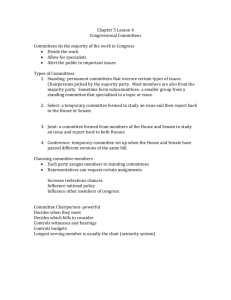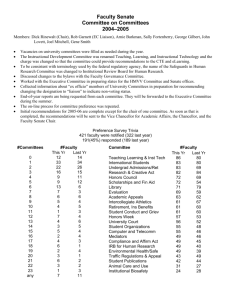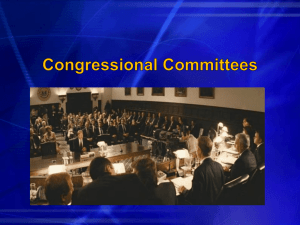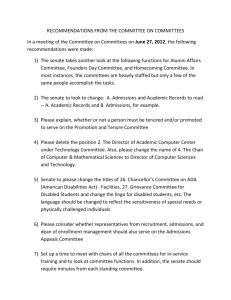Ch5Sec34PP
advertisement
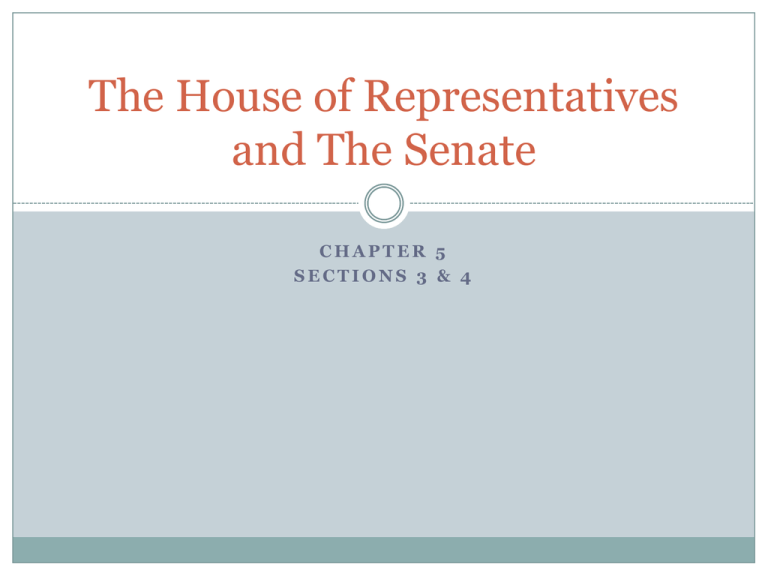
The House of Representatives and The Senate CHAPTER 5 SECTIONS 3 & 4 The House of Representatives Main Idea The House of Representatives, with its frequent elections and regular reapportionment, is the more representative chamber of Congress. Its members carry out much of their work in committees. Reading Focus • • • • What are the key features of the House of Representatives and its membership? What are some of the challenges that reapportionment and redistricting raise? How is the leadership of the House organized? What is the role of committees in the operation of the House? Membership in the House Formal Qualifications • House members chosen by direct popular vote • According to Constitution, House is responsible for “Elections, Returns, and Qualifications of its own Members” • Representative must be at least 25 years old and resident of state he or she represents. • Members must also have been U.S. citizen at least 7 years Informal Qualifications • Candidates with military backgrounds, celebrities often popular choices for House membership • Ability to raise significant funds for campaigning is important informal qualification for House membership Reapportionment and Redistricting Changes in Population • Each state must have at least one representative • Constitution requires that House redistribute number of seats available to each state every 10 years • Reapportionment based on most current census figures Gerrymandering • State governments responsible for creating voting districts within state • Gerrymandering: redrawing district boundaries for political gain One Person, One Vote • According to Constitution, each person’s vote must have same basic value • Gerrymandering has been used to disenfranchise racial minorities • Supreme Court has restricted use of gerrymandering Leadership in the House The Speaker of the House • The presiding officer of the House is called the Speaker of the House. —Elected by his or her peers — Member of majority party • The Speaker has authority over much of the business of the House. — Presides over debates — Rules on points of order — Assigns bills to committees • The Speaker is behind the vice president in the line of succession to the presidency. Leadership in the House (cont’d.) Other Leadership Posts • • • • Party officers elected at beginning of term at party caucus Both Democratic and Republican Parties elect floor leader Majority leader serves as assistant to Speaker of the House Both parties elect whips, function is to secure votes in line with party leadership House Rules • House has congressional authority to make own rules • House Rules Committee very powerful, responsible for setting conditions under which bills are debated The Role of Committees Standing Committees • Standing committees: permanent committees that address broad topics • Subcommittees: specialize in areas within a broader topic Committee Chairs • Position of committee chair very powerful • Chairs chosen by majority party • Position usually goes to most senior member on committee” Other Committees • Select committees: meant to carry out specific task • Joint committees include both House and Senate members; address issues that affect both chambers Committee Membership • House members usually serve on two standing committees, four subcommittees at a time • Members request assignments based on personal interest, concerns of constituents The Senate Main Idea Senators represent entire states, have longer terms, and follow different rules of debate. These features help give the Senate its reputation as a more weighty and careful body than the House. Reading Focus • • • • What are the major features of the Senate and its membership? What are the Senate’s leadership posts? What is the role of committees in the Senate? What are some of the distinctive rules and traditions of the Senate? The Power of the Speaker The Senate and Its Membership Formal Qualifications • Must be at least 30 years old • Must reside in state he or she represents • Must be U.S. citizen at least nine years • Serve six-year terms Informal Qualifications • Tend to be older and wealthier than House members • Senate does not reflect diversity of U.S. population • Less diverse body than HouseElection of Senators Election of Senators • State legislatures originally chose senators • Since 1913, 17th Amendment, elected by direct popular vote Senate Leadership Constitutional Positions • Senate’s presiding officer —Vice president of the United States is president of the Senate —Largely ceremonial; votes only in circumstance of tie, casts deciding vote • When presiding officer absent —President pro tempore presides in absence of president of the Senate, traditionally longest-serving senator of majority party —Third in line in presidential succession behind Speaker of the House Party Leaders • Leading the majority —Senate majority leader most powerful position in Senate —Chosen by party caucus, works to fulfill party’s agenda in Senate • Minority leader guides work of minority party in Senate Committees in the Senate Types of Senate Committees • 16 standing committees and dozens of subcommittees • Assignments allow senators to become familiar with specific issues of public policy Committee Chairs • No senator can chair more than one committee • Committee chairmanships generally chosen by seniority rule Membership in Committees • Usually serve on three committees and five subcommittees • Members seek assignments that align with constituents’ concerns and personal interests. Senate Committee Power • Top nominees of president reviewed by relevant Senate committee • Debate and vote on treaties, need twothirds majority to become law Rules and Traditions The Filibuster • Senate places fewer limits on debate than House • Senators may use stalling tactics like filibuster —Opponents of measure refuse to stop talking hoping to prevent measure from coming to vote —Cloture can limit filibuster, requires two-thirds vote to end debate Discipline in the Senate • Constitution states Senate should judge conduct of own members • Senators can be expelled or censured Filling Vacancies • Vacancy occurs if senator dies in office or retires during term • State’s governor appoints temporary replacement Reapportionment The process in which seats are redistributed among states based on the results of the census. Gerrymandering The practice of drawing district boundaries for political advantage Speaker of the House The most powerful member and the presiding office of the House of Representatives Bills Proposed laws Floor Leader Elected member of the majority or minority part who helps manage the actions and strategy of the party in the House of Representatives Whips Elected members of the majority or minority party who encourage fellow party members to vote as the party leadership wants Party Caucus A meeting of all the House of Representatives members from a particular party Standing Committees Permanent committees in the House of Representatives Vocabulary Select Committees Committees, typically temporary, that carry out specific tasks not already covered by existing committees Joint Committees Committees formed with Senate members that address broad issues affecting both chambers President of the Senate Position assigned to the vice president of the US by the Constitution that allows the VP to preside over debates and break tie votes President Pro Tempore The person who presides over the Senate in the absence of the president of the Senate Senate Majority Leader The most powerful position in the Senate, elected by the majority’s party caucus Seniority Rule Tradition that says the most senior majority senator on a committee becomes committee chair Filibuster When opponents of a measure take control of the Senate floor and refuse to stop talking in an effort to prevent the measure from coming up for a vote
